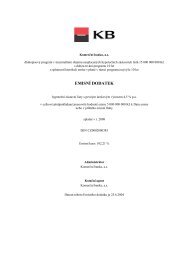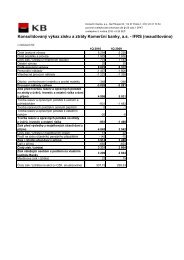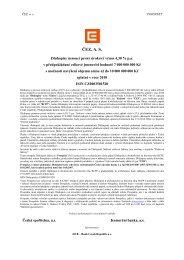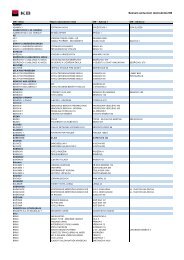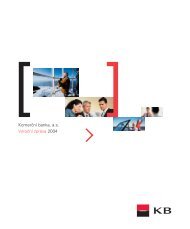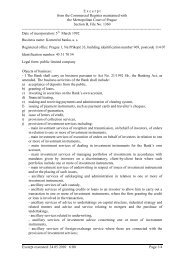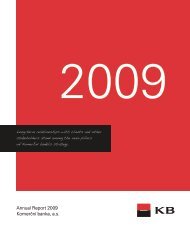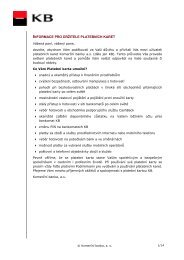KB prezent. angl - Komerční banka
KB prezent. angl - Komerční banka
KB prezent. angl - Komerční banka
You also want an ePaper? Increase the reach of your titles
YUMPU automatically turns print PDFs into web optimized ePapers that Google loves.
154 ➔155<br />
Consolidated Financial Statements<br />
under IFRS<br />
38. Risk management and financial instruments<br />
(A) Credit risk<br />
Credit rating of borrowers<br />
The Group quantifies counterparty risk using ratings on the basis of a number of criteria depending upon the type and size of the<br />
borrower. The rating of the borrower serves as a basis for calculating anticipated risk expenses taking into account the type of the<br />
credit product and underlying collateral. The Group rates corporate borrowers based upon quantitative (financial statements of an<br />
enterprise) and qualitative (gradings assigned by financial analysts) criteria. The quantitative analysis of the financial statements is<br />
undertaken using various ratios depending upon the size of the borrower (turnover) and type of business (manufacturing, leasing,<br />
municipality). The used methodology is based upon the methodology implemented throughout the whole Société Générale Group.<br />
The Group additionally refers to ratings published by external rating agencies. With effect from 2003, the Group has also used the<br />
information supplied by the Central Loan Register (information about legal entities) operated by the Czech National Bank to which<br />
banks are required to provide relevant information. Special teams regularly assess the ratings assigned to individual borrowers for<br />
correctness and accuracy. In arriving at the rating of retail clients, the Group principally uses quantitative criteria as well as<br />
information supplied by the Client Information Bank Register (information about individuals – citizens and businessmen) operated by<br />
CBCB, a. s.<br />
The Group monitors credit risk concentrations on an aggregate basis in respect of all on and off balance sheet positions. The Group<br />
specifically monitors credit risk concentrations by industry and groups of economically linked entities. With a view to identifying<br />
significant credit risk concentrations, the Group compares the proportion of industries to its on and off balance sheet position and the<br />
proportion of industries in the Czech Republic (share of GDP). With regard to groups of economically linked entities, the Group<br />
monitors the proportion of credit exposures to the groups to the Group’s capital.<br />
Receivables that are not categorised<br />
The Group does not classify other amounts due from customers pursuant to the applicable regulation issued by the Czech National<br />
Bank. These amounts consist of non-loan receivables that principally originated from the system of payment, fraudulent withdrawals,<br />
bank cheques, receivables associated with purchases of securities on behalf of clients that have not been settled, and balances<br />
receivable that arise from business arrangements that do not represent financial activities, specifically prepayments made to social<br />
security authorities and amounts due from these authorities. As a general policy, the Group records full provisions against these<br />
balances if they are overdue by three months or greater.<br />
Provisioning for receivables<br />
The Group charges provisions against amounts due from borrowers by reference to the uncovered exposure which represents the<br />
balance receivable after deducting eligible collateral. The Group is prudent in determining the level of provisioning. The provisioning<br />
charge is equal to the greater of the provision calculated pursuant to the CNB Regulation, which provides guidance on loan<br />
classification and provisioning for loans on the basis of their classification, and the provision determined on the basis of the<br />
Group’s internal estimate of the expected recovery rates of individual receivables. The Group uses this approach both in respect of on<br />
and off balance sheet exposures. The Group also establishes full provisions against past due interest payments and accrued interest<br />
on substandard, doubtful and loss receivables.<br />
Pursuant to the applicable CNB regulation, loan classification grades are determined using the following parameters: “Analysis of the<br />
client’s financial position”, “Number of overdue days”, “Provision of information by the client”, “Restructuring of the receivable” and<br />
“Initiation of liquidation”. An internal assessment of the loan is determined using a counterparty rating and ratings prepared by<br />
analysts. Significant loan exposures are discussed by the Provisioning Committees (a significant proportion of the Group’s loan<br />
portfolio is reviewed by these Committees).



